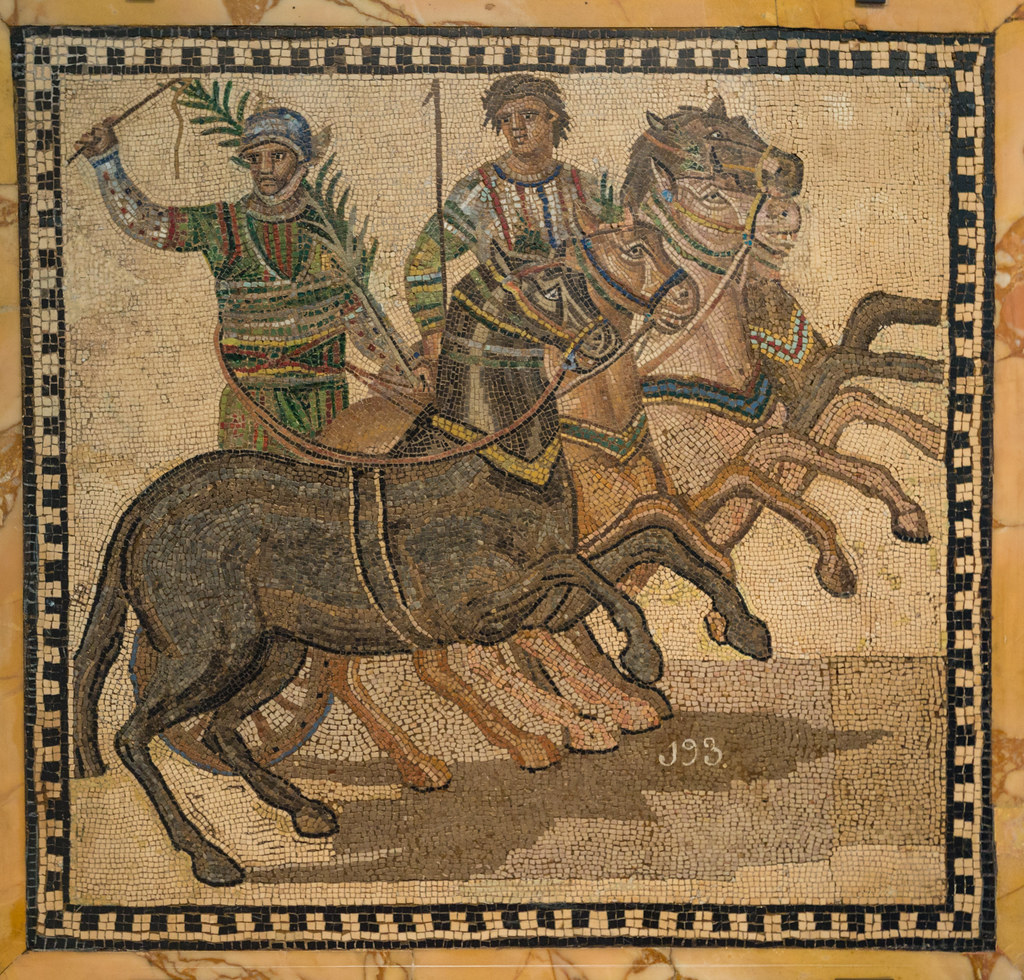
The Romans were not a horse based culture (notice how their armies were primarily infantry), but they use horses for a variety of purposes including transportation, farming, and warfare (yes, even after I just said that other thing). They were great scouts, when ridden by a person. On their own, they were pretty terrible scouts.
They were also used in chariot racing, which was a pretty popular pastime for people with lots of money. But also people who didn’t have lots of money liked to watch, so it kind of benefited everyone.
But overall, horses were ingrained into the culture of the Romans. So what was their deal with the horseshoes, you might be asking, since that’s the title of this post.
Well, the first source we have was the famous Xenophon, who wrote the equally famous On Horsemanship in 355 BC. Although he was actually Greek, not Roman, his works were widely read and admired by the Romans. In the section about horse care, he did not mention horse shoes. He was considered a very big horse influencer at the time, so if horse shoes had been in use, he would have mentioned it or risk being laughed at for not being on top of trending topics.
We can likely assume that as of that writing, horse shoes still didn’t exist.

Horseshoes in Art (Or a Lack There of)

Over 500 years later in 175 AD, a statue of Marcus Aurelius riding a horse was erected in Rome. This statue was created to honor a victory of the emperor, and stands larger than life at 13.9 feet tall. It is one of the few remaining early bronze statues, as it was common to melt them down for other uses.
The emperor is riding a horse (with no stirrups since they did not exist in that part of the world yet), and carrying no weapons, as he considered himself a bringer of peace.
The horse he is riding is unshod.
In artwork from the time, horse shoes are not depicted. Is it lazy artists? (The horse also has no reins, so could be that, or Marcus Aurelius is really just that good or a rider.) Or is this an accurate depiction of the equipment a horse would have had back then?
Art is an interesting source for history, as details can give us insight to what life was like at the time. For example, we can see the common hairstyle at a time, or see what items were being used, if the artist shows them. Of course, this isn’t always accurate, dragons were featured in many medieval artworks and we all know they were extinct by then. So considering this, it’s possible that in 175 AD, horse shoes as we know them today were not in common use in Rome.
In addition to the statue, other early Roman art failed to depict horse shoes. Surviving mosaics and carvings depict the well formed, but barefoot, horse. It’s possible that all of the civilization made a joint decision to just leave horseshoes out of it, but chances are high that they just didn’t exist yet.
Roman Hipposandals
Around the 2nd century AD, the Romans, aware of the need for shoes but unable to yet figure out the mysteries of the hoof yet, used Hipposandals, which is similar to our modern hoof boot. Much like the leather booties used in ancient Asian, the hipposandals were constructed with a thick metal plate which was secured to the hoof with leather laces, much like the human sandals worn at the time (and still worn now, by stylish humans.)
They were used around the mid-1st century AD, and while a few of these specimens survived through the ravages of time, it’s not clear if they were actually in regular use. It would appear that the function of the hipposandal was to give horses better traction and protect the hoof on rough ground, but the design was not great.
In 2006, a British television station decided to test the hipposandal by having a farrier recreate one based on the ancient design. The horse was reported to be very uncomfortable, walked awkwardly, and the farrier was concerned that it would catch its legs on the spike of the shoe. He recommended not having the horse pull heavy loads or trot at all while wearing it, but it’s unclear if he would be able to communicate this message to the past, unless time is a flat circle, in which case he might be able to leave them a note to find when the loop starts again.
But his findings do defeat the entire purpose of wearing the hipposandals, unless they were just trying to be very stylish horses. Because as we all know, being comfortable is usually the opposite of being stylish.
The Roman hipposandals hung around for a while, and even seemed to briefly co-exist with nailed on shoes in the 5th century AD. But, everyone quickly noticed that nailed on shoes were clearly better and were struck with a mutual embarrassment for having ever liked hipposandals. It was the end for hipposandals, except for later display in the British museum, the home of all the world’s artifacts.
Interested in more horse shoe history? See the origin of the horse shoe in Asia and The Etruscan Horsehoes.

Glue On HorseShoes - An Equestrian Life
[…] The Original Horse boots: Hipposandals […]
The Invention of the Nail-On Horseshoe - An Equestrian Life
[…] use a nail to attach it to an animal’s hoof. First they tied on woven grass or leather, and then it was metal, but still tied on. The Romans used the hipposandal, but it was pretty awkward and everyone was […]